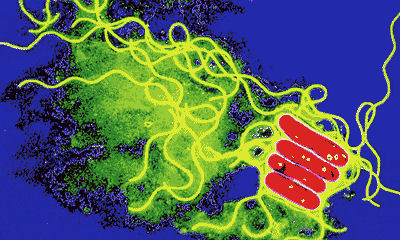What Is Legionnaires' Disease?

Legionnaires' disease, or legionellosis, is a potentially fatal form of lung infection (pneumonia) caused by the bacterium
Legionella pneumophila. The disease was first identified in 1976 when a group of American Legionnaires contracted it at a
convention in Philadelphia during which 34 of 221 persons died, the previously unrecognised bacterium was isolated from lung
tissue samples. It has since been proved that the disease existed long before this discovery date, with the earliest isolation
from preserved matter being dated back to 1947.
Where Does Legionella bacteria occur?
Legionella pneumophila belongs to the Legionellaceae family which now includes 48 species and over 70 serogroups of which
it is believed that half are susceptible to humans. Legionella organisms are residents of the aquatic environment with rare
cases being recorded from soil.
When Can Legionella Bacteria Live?

In order to multiply legionella also requires a source of nutrients, many of which readily occur in the aquatic environment,
such as algae, amoebae and other bacteria. Within a water system the presence of sediment, sludge, scale and biofilms also
provides an ideal habitat for legionellae multiplication.
How Do You Catch Legionnaires' Disease?
The disease is usually contracted by breathing in infected water droplets, but highly susceptible individuals can also
contract it by inhaling contaminated droplets while drinking water.
How many people catch Legionnaires' Disease
It is estimated that there are 200 cases of the disease in the UK each year with about 20% of these being fatal, in the
United States between 8,000 and 18,000 people contract the disease each year. The largest ever single outbreak of
Legionnaires' disease was in Murcia Spain, July 2001 with 650 Cases and 4 Deaths.
What Are The Symptoms Of Legionnaires Disease?
Legionnaires disease typically incubates over a period of two to ten days. Initial symptoms are likely to include high
fever with temperatures often greater than 39.5°C (103°F), chills, headaches and muscle pain. A dry cough may also appear
and more often than not the patient will have difficulty breathing. In about one third of cases the patients will develop
diarrhoea or vomiting and half will become confused or delirious. It is quite common for exposed people to avoid showing
full blown symptoms and many will only get a mild flu-like infection. The disease is not however contagious.
What Is The Treatment For Legionnaires' Disease?
The goal of treatment is to eliminate the legionella bacterium with antibiotics. Treatment is started as soon as
Legionnaires' Disease is suspected. Because the bacteria are intracellular, antibiotics that can penetrate infected cells
must be chosen. Erythromycin is the most widely used, however, combinations of Erythromycin and Rifampin are often just as
effective.
How Does Legionella Bacteria Avoid The Immune System?
Legionella rely on the aspiration (choking) to enter the respiratory tract. They escape the gag reflex, along with other
foreign particles and are then able to reach the lung where they can infect. The bodies natural defence against these
bacterium and other foreign bodies is to have a series of microscopic hairs lining the windpipe which work in motion to
carry the unwanted body back to the mouth with the aid of lubricating mucus. Once in the mouth the foreign body mucus mix
is then swallowed and lost in the digestive system.
Who Can Catch Legionnaires Disease?
The effectiveness of Cilia in ill, the elderly, heavy drinkers, smokers and people receiving medical treatment
(e.g. chemotherapy) is dramatically reduced and they are therefore more susceptible to the disease due to the significantly
lower number of legionellae required to cause an infection. Young, healthy people can still catch l.d however and there have
even been cases of immunocompetent children catching it. These susceptibility criteria not only affect the chances of
catching the disease but also the probability of the disease being fatal if it is contracted.
What Is The Mortality Rate?
The overall average death rate after infection is 12%, a mortality rate of over 50% has been reported however in certain
outbreaks. Those that survive the disease, and have been discharged from hospital, have reported negative post infectual
symptoms such as joint pain or muscle weakness that can last for up to 17 months after the infection was first diagnosed.
What Are The Implications For Water Systems?
If the conditions anywhere within a water system are favourable for the bacteria to multiply they will, dramatically
increasing the chances of someone becoming infected. It is therefore essential that all water systems are maintained to a
non-favourable condition for legionella. Favourable conditions for legionella include stagnent water, a suitable temperature,
sediment to adhere to, and symbiotic microorganisms for growth.
Who Has Responsibility For The Water System At My Place Of Work?
Employers and those with responsibilities for the control of premises are bound by law to follow a checklist detailing their
necessary actions in reducing the risk as far is practicable in the control of the disease.
View the full checklist here
What Government Publications Are Available About Legionella Control?
Legionnaires Disease: The control of legionella bacteria in water systems. Approved code of practice and guidance. L8,
Health and Safety Executive, 2000. ISBN 0717617726. This ACoP specifies the precations that need to be taken against
Legionella bacteria in all water systems. If their recommendations are not followed then in any court case you would have to
prove that the precautions you were taking were the equivalent or better.
BS6700-British Standard Specification for design, installation, testing and maintenance of services supplying water for
domestic use within buildings and their curtilages. This document specifies that all new pipework installations to
non-private dwellings should be subjected to a 1 hour soak of water containing 50ppm free chlorine before the pipework can
be commissioned.
Legionnaires Disease Good Practice for Plumbers, The Institute of Plumbing - "Too many people do not realise the risks of
this potentially killing disease until they are pointed out" A guide for plumbers and similar trades in dealing with the
potential hazard to health and life posed by Legionnaires' disease.
If you would like further information on how S.A.S can help you control your water system against l.d please call and
our staff will be happy to help.